|
|
|
Sort Order |
|
|
|
Items / Page
|
|
|
|
|
|
|
| Srl | Item |
| 1 |
ID:
113363


|
|
|
|
|
| Publication |
2012.
|
| Summary/Abstract |
This article analyses Middle Eastern authoritarianism and the contemporary political transformations which have swept the region. It suggests that, given the uneven spread of reform and the selectiveness of international intervention, the prioritisation of Middle Eastern stability over democratic transformation, combined with local authoritarian regimes' ability to use excessive force against their own populations and insurgents, are responsible for the persistence of the Middle East's post-cold war authoritarianism. The recent uprisings and reform movements can be explained from the perspective of historical grievance, based on social inequality and ethnic, sectarian, tribal or sectional disparities, as well as by advancements in communications technology and economic globalisation that have undermined long-standing national authoritarianism in favour of Middle Eastern civil rights and civil society movements. A global democratic consciousness has played a decisive role in providing ideological cohesiveness and (uneven) global political support to safeguard the collective action of the new civil rights movements. Recognising that democracy itself may have characteristic regional forms with greater and lesser tinges of recurrent authoritarianism, Middle Eastern democratic transformation hinges on the ability of these burgeoning movements to achieve a civic state and overcome authoritarian counter-resistance and international suspicion and fear.
|
|
|
|
|
|
|
|
|
|
|
|
|
|
|
|
| 2 |
ID:
153235
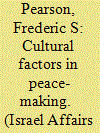

|
|
|
|
|
| Summary/Abstract |
The importance of culture, while recognized, has received proportionately less attention than political and economic issues and objective interests in settling political disputes. Traditional ways of understanding conflict and approaches to reconciliation nevertheless appear to play a major role in the frequent breakdown of peace agreements, as parties’ underlying needs and expectations are not met. A review of data on peace agreements in the Middle East as compared to the rest of the world shows that power imbalance, perceptions of injustice and the authority of potential mediators play especially important roles in success. In cases of inter-Arab and Arab–Israeli conflict, reconciliation requires power rebalance, demonstrated mutual respect and security guarantees.
|
|
|
|
|
|
|
|
|
|
|
|
|
|
|
|
| 3 |
ID:
004945
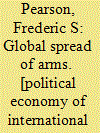

|
|
|
|
|
| Publication |
Boulder, Westview Press, 1994.
|
| Description |
xi,161p.
|
| Standard Number |
0813315743
|
|
|
|
|
|
|
|
|
|
|
|
Copies: C:1/I:0,R:0,Q:0
Circulation
| Accession# | Call# | Current Location | Status | Policy | Location |
| 036018 | 382.456234/PEA 036018 | Main | On Shelf | General | |
|
|
|
|
| 4 |
ID:
152886
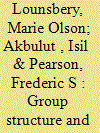

|
|
|
|
|
| Summary/Abstract |
Studies have begun to look at the potentially crucial impacts of group decentralization and inter-group global networking in accounting for the extent and severity of violence in insurgencies and terrorism. Groups may be able to survive more effectively, evade anti-terror or counter-insurgency strategies, and inflict greater damage or more civilian attacks by operating under more or less centralized leadership, or by making use of the resources of other like-minded groups scattered across borders. While some analysts have examined each of these possibilities, few if any have done so simultaneously with both structural and networking indicators or examined the joint effects of these indicators. We propose to do so in this study by combining existing datasets on terrorist structure and networks. Hypotheses and findings in prior studies have indicated that structural decentralization may lead to more civilian attacks if not more destruction since local cells are freer to act on their own, and that group size and centrality in the global terror networks lead to greater lethality and group survival rates. We re-examine such assumptions here with OLS and logit models combining these effects, and find that in addition to group size, network reach (eigenvalue centrality) rather than group interconnections per se (number of allies) appears to have primary impacts on group lethality, targeting, and survival, sometimes in conjunction with decentralized organizational structure.
|
|
|
|
|
|
|
|
|
|
|
|
|
|
|
|
| 5 |
ID:
187386


|
|
|
|
|
| Summary/Abstract |
Amidst the war in Ukraine, it is important to raise the prospect and vision of creating mutual security guarantees and ridding Europe of its dangerous nuclear weapon systems and provocative force deployments. In view of reckless Kremlin rhetoric and aggressive military action in Russia’s so-called near abroad, it is time for renewed approaches to arms control. As the Ukraine situation plays out, Russia, the United States, and allies in the North Atlantic Treaty Organization must return to their bargaining tables and negotiate strict limits, verification measures, and overarching controls over their nuclear use doctrines, weapon stockpiles, and conventional force deployments. All sides will have to make deep concessions and de-alert and de-operationalize mid- and short-range nuclear weapons while improving command and control safeguards—because, as we see, brandishing weapons and threatening escalation heightens tensions and increases the danger of crises spiralling uncontrollably.
|
|
|
|
|
|
|
|
|
|
|
|
|
|
|
|
| 6 |
ID:
192884
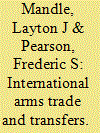

|
|
|
|
|
| Summary/Abstract |
The end of the Cold War era has ushered in a century in which great military powers like the US, China, and Russia continue to dominate the arms trade, yet minor powers are also investing heavily in arms manufacturing and technologies and profiting from lucrative arms transfers. Changes in the arms trade have fostered cooperative international regulatory practices and agreements, but recent conflicts in Yemen, Syria, Libya, Nagorno-Karabakh, and Ukraine highlight the need for strong end-use monitoring, post-shipment verification, and international accountability for dubious trade deals. This study analyzes changes in top arms producers, new complexities in arms regulation due to advancing technologies and artificial intelligence, arms-control policies of international organizations and top arms producers, and the risks of poor regulation.
|
|
|
|
|
|
|
|
|
|
|
|
|
|
|
|
| 7 |
ID:
110030


|
|
|
|
|
| Publication |
2012.
|
| Summary/Abstract |
The article offers a critical comparison between two extreme cases of the Minds of Peace Experiment: the Detroit round (May 2009) and the first round in Israel-Palestine (Beit Jala - August 2009). It explores the question of residential location in an age of globalization as influencing reconciliation prospects in intractable disputes. Most of the participants in Detroit were Israelis and Palestinians who lived for many years in the Diaspora, while the panellists in Beit Jala reside in Israel or the West Bank. The interactions between the participants and the outcomes of the two rounds differed markedly in ways traceable to contrasting perspectives on interests and agendas. Diaspora participants tended to value issues such as justice and refugee return, while those proximate to the conflict tended to emphasize relief of everyday local grievances. The article grapples with the effects of variables such as the length of time removed from the former homeland, circumstances of departure, the degree of continued contact, and differences of political systems. It explores in essence whether and in what sense the Diaspora might play a constructive role in the struggle to bring peace and stability to the Middle East.
|
|
|
|
|
|
|
|
|
|
|
|
|
|
|
|
| 8 |
ID:
110028
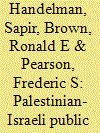

|
|
|
|
|
| Publication |
2012.
|
| Summary/Abstract |
This paper draws lessons from the role played by the black church in creating support for the US civil rights movement in relation to the struggle to involve the Palestinian and the Israeli people directly in the peacemaking efforts to resolve their tragic conflict. The civil rights struggle in both the US and South Africa eventually engaged large segments of the public in both productive debate and campaigning. The corresponding impetus now is to create a major Palestinian-Israeli public negotiating congress that can involve ordinary citizens on both sides in the peacemaking efforts. The Minds of Peace Experiment, a small-scale Palestinian-Israeli public negotiating assembly, is designed to demonstrate the peacemaking power of a subsequent major congress. The exercise, which has been conducted around the US, Canada, and the Middle East, succeeded in creating peacemaking coalitions that are based on commitment to promote the culture of peace. The question is: how can you transform this peacemaking effect into a mass movement? The American black church movement as well as the South African mass mobilization can offer important indications of effective strategy.
|
|
|
|
|
|
|
|
|
|
|
|
|
|
|
|
| 9 |
ID:
129046


|
|
|
|
|
| Publication |
2014.
|
| Summary/Abstract |
This article presents a contractualist approach to peace and conflict studies that grows out of classical paradigms in the field. The contractualist approach proposes a solution to intractable conflicts through processes such as a public negotiating congress to transform conflicting parties into a large peacemaking community. The vision of an ideal congress is based on the multi-party talks that had operated in South Africa and Northern Ireland during the 1990s. The challenge is to establish a similar peacemaking institution in cases such as the Israeli-Palestinian dispute where ordinary citizens are at the center of the struggle. This article includes theoretical background, analysis of relevant case studies, and lessons from the Minds of Peace Experiment, a small-scale Israeli-Palestinian public negotiating congress that has held sessions in various locations around the world.
|
|
|
|
|
|
|
|
|
|
|
|
|
|
|
|
| 10 |
ID:
102494


|
|
|
|
|
| Publication |
2011.
|
| Summary/Abstract |
Regardless of the types of civil conflict settlements, all parties generally enter into some sorts of tacit or direct bargaining in the course of civil conflict, namely, in steps toward peace. In contrast to a basically static framework employed in much of existing literature on civil war settlements and mediation, this article proposes a disaggregate approach to dynamic and multi-phase processes in civil conflict termination via negotiations. We illustrate a conceptual and theoretical framework to examine four steps in civil conflict settlements in a large-N research program. In so doing, we present an initial effort to construct a dyadic dataset isolating processes that allow civil conflict settlements to progress or regress between low and higher levels of agreement in the Asia-Pacific region from 1990 to 2005. We discuss a set of preliminary simple statistical results for the four distinct settlement phases in the context of conflict and rebel characteristics. Among the findings of note, third parties provide important assistance in nurturing successful negotiations especially in the context of waning insurgent strength. Peace proposals originate most frequently from governments, and seem to hinge especially on opponents' battlefield advantages. Evidence of mutually hurting stalemates is also found. In the article's conclusion we elaborate a long-term research agenda.
|
|
|
|
|
|
|
|
|
|
|
|
|
|
|
|
| 11 |
ID:
174100


|
|
|
|
|
| Summary/Abstract |
Recent trends in international responses to civil war and humanitarian crises highlight the growing importance of multilateral intervention by intergovernmental organizations (IGOs). Academics and practitioners agree that higher levels of cooperation should yield better outcomes, while the literature emphasizes the importance of commitment. Yet the question of how organizations collaborate with each other and local authorities remains largely uncharted, despite its growing importance for the future of international peacemaking and peacebuilding. This paper analyzes DDR processes within the context of organizational networks and programme ‘ownership.’ It extends existing literature by adding nuanced understandings of ownership and assessment of the interactive processes through which the programme is offered as factors in understanding outcomes. The paper focuses on two factors – ownership and collaboration (both type and scope) –to analyze how IGOs interact and in particular comprise or respond to the local/international nexus of DDR peacemaking and peacebuilding. Its findings suggest that no single factor is sufficient for understanding DDR outcomes. Contrary to standard beliefs, the locus of ownership of may not be as critical as other factors, and context may be more important to outcomes than incentives. These findings define areas for further research related to specific combinations of factors and the causal dynamics and challenges of collaboration among participants.
|
|
|
|
|
|
|
|
|
|
|
|
|
|
|
|
|
|
|
|
|